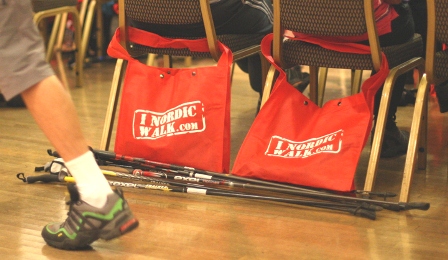Making strides: Nordic walkers convene in London
With colleagues from around the world descending on Hyde Park to talk about and try new developments in Nordic walking, Catherine Hughes packed her poles and joined them.
To many people Nordic walking looks suspiciously like cross-country skiing without the snow, which is no great surprise given that the sport, which is now practised in upwards of 40 countries, originally evolved as a summer training alternative for top-class Nordic skiers. Since its inception the offshoot activity has grown and developed, and there is now a fully fledged International Nordic Walking Federation (INWA) based in Finland with outposts around the globe. With the sport blossoming in Britain, this year’s INWA convention came to London and, with 90 people from 16 countries, it was one of the best-attended so far.
The Victory Services Club provided a tremendous venue, standing as it does two minutes from Marble Arch, a stone’s throw from the West End – people do like to see the sights when they have travelled half way round the world – and just around the corner from Hyde Park, a superb location for the convention’s practical sessions that were made even more special by some rather lovely weather. The Thursday evening reception to welcome the overseas contingent in particular gave people a chance to catch up with friends old and new, and if the combination of Pimms and curry may have seemed incongruous on paper, the open-minded approach and a willingness to learn that such a menu required set the tone for the next three days.
The convention proper opened with a presentation from Natalie Kavanagh-Clare of Run England, an organisation with very similar aims to British Nordic Walking (BNW). Both are seeking to increase participation in physical activity by setting up local groups aimed at people new to exercise and even the sport-resistant. BNW have just set up a project in Melbourne in partnership with Jog Derbyshire where Martin Stephens, one of the jog leaders, is also a Nordic walking instructor. He runs both Nordic walking and jogging groups at the same time and location, which allows people to switch between the two depending on their level of fitness. The migration of people between Nordic walking and running moves both ways, with Nordic walkers moving into running after a year building up their fitness and strength, and runners who find themselves complaining about knees or backs deciding to take up Nordic walking instead. They still get a workout and, with BNW recently gaining approval from UK Athletics, they can still take part in races into the bargain.
The convention then moved into the outdoors with Naohiro, the Japanese cross-country ski champion, demonstrating some higher-intensity moves. These included Nordic running, bounding, press ups, burpees with the poles (which is very hard), core exercises and some challenging balance exercises thrown in for good measure. The second of the day’s practicals invited delegates to try out the latest running trend, barefoot running, with James Maslin from Merrell shoes. The claims for these shoes – that they bring benefits to posture, balance and cadence to overall fitness – are naturally of interest to the Nordic walking community and, encouraged by the short taster of barefoot Nordic walking, the intention is to investigate this further over the next year.
The convention’s second day focused on health with Paul Waters of Lifetime Training speaking on GP referral schemes, followed by an inspirational presentation from New Zealand where they have many examples of using Nordic walking for injury rehabilitation. The story told by Ryan Taylor, a base jumper from Vanuatu whose parachute malfunctioned one day in 2004, was the most remarkable. He was lucky to survive the fall and was in a coma for six weeks but progressed to being able to function in a wheelchair and then learned to walk with a Zimmer frame. After leaving the brain injury unit in Sidney, where he was recovering, he travelled to New Zealand to work with June Stevenson who, as well as being a physiotherapist, is also the head of Nordic walking in her country. Since then he has made huge progress with relearning to walk. His trip to the United Kingdom for the convention was his first solo outing and he joined in with all the practical sessions, displaying only a very slight limp. The final speaker Alma Thomas, a world-leading sports psychologist and performance enhancement consultant,gave a thought-provoking presentation on motivation to exercise despite having just stepped off the plane from Los Angeles. She had sound advice for all of us who aim to encourage people to do more.
To round off the event in appropriate style the convention finished with a 5km Nordic walk in Hyde Park, the first event of its kind. With the sun shining there was a great sense of camaraderie among the participants, who ranged from the 72-year-old president of the Japanese Nordic Fitness Association to a nine-year-old local girl.
A few days later, with the dust settling on the convention, the word came through that Parkrun, an organisation which organises community runs that are free to attend, has agreed that Nordic walkers can take part in their weekly series of over 100 events which happen from Austria to Denmark and from Poland to Afghanistan. Nordic walking really is making strides.
Catherine Hughes is the director of British Nordic Walking whose website can be found at www.britishnordicwalking.org.uk
The Leisure Review, November 2011
© Copyright of all material on this site is retained by The Leisure Review or the individual contributors where stated. Contact The Leisure Review for details.
Download a pdf version of this article for printing
